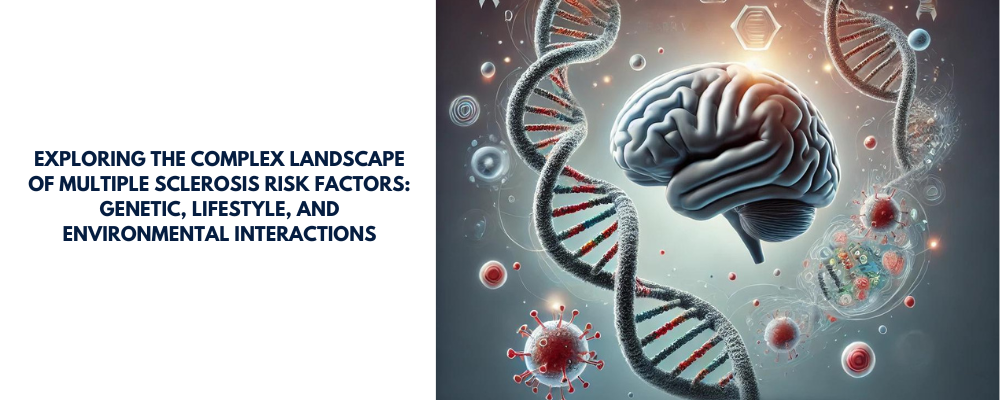Exploring the Complex Landscape of Multiple Sclerosis Risk Factors: Genetic, Lifestyle, and Environmental Interactions

Multiple sclerosis (MS) is a complex immune-mediated neurodegenerative disease that affects the central nervous system (CNS), leading to a range of neurological symptoms. While genetic predisposition is a significant factor, it explains only a fraction of the disease risk. A growing body of evidence emphasizes the influence of lifestyle and environmental factors, many of which can be modified, offering potential strategies for disease prevention. In this post, we explore how genetic and environmental factors interact in MS, focusing on key risk elements such as Epstein-Barr virus (EBV) infection, smoking, and vitamin D deficiency.
Genetic Predisposition
The human leukocyte antigen (HLA) complex plays a critical role in immune regulation, and certain HLA variants have been identified as the strongest genetic risk factors for MS. Specifically, the HLA-DRB115:01 allele is associated with a significantly increased risk of MS, while the HLA-A02 allele appears to be protective. These genetic factors are key in modulating adaptive immune responses, which are central to the development of MS.
Vitamin D Deficiency: The Role of Sun Exposure
Latitude-dependent variations in MS prevalence have long suggested a role for vitamin D and sun exposure in disease risk. Low levels of vitamin D, often due to insufficient sun exposure, have been linked to an increased risk of MS. Vitamin D is known to modulate immune responses, and genetic studies have identified polymorphisms in vitamin D metabolism genes that are associated with MS susceptibility. Importantly, vitamin D supplementation during adolescence may help mitigate the risk of developing MS.
Epstein-Barr Virus (EBV): A Persistent Viral Trigger
EBV, the virus responsible for infectious mononucleosis, has been consistently linked to an increased risk of MS. Individuals who have experienced EBV infection, particularly during adolescence, have a greater likelihood of developing MS later in life. Interestingly, EBV interacts with the MS-associated HLA-DRB1*15:01 allele, pointing to a shared immunological pathway. Elevated levels of EBV antibodies in MS patients suggest a potential causal role for the virus in triggering autoimmune responses against CNS tissue.
Smoking: An Amplified Risk with Genetic Interaction
Smoking is another well-established risk factor for MS, with both direct and passive exposure contributing to disease risk. Smokers who carry the HLA-DRB1*15:01 allele face a significantly higher risk of MS, underscoring the potent gene-environment interaction. Moreover, smoking is not only linked to an increased risk of developing MS but also to a worse prognosis, accelerating disease progression and reducing the efficacy of certain MS therapies.
Interactions Between Risk Factors: A Synergistic Effect
One of the key takeaways from recent research is the synergistic effect of multiple risk factors in MS. For example, individuals with both a history of EBV infection and adolescent obesity face a dramatically increased risk of MS. Similarly, the combination of smoking and genetic susceptibility greatly amplifies the likelihood of developing the disease. These findings highlight the importance of considering both genetic predisposition and environmental exposures when assessing MS risk.
Practical Implications for Prevention
The identification of modifiable risk factors opens new avenues for MS prevention, particularly for individuals with a family history of the disease. Public health strategies that promote smoking cessation, healthy weight management during adolescence, and adequate vitamin D levels through sun exposure or supplementation could help reduce the incidence of MS. Additionally, understanding the interactions between genetic and environmental factors may lead to more personalized prevention strategies for those at the highest risk.
Conclusion: A Multifactorial Approach to Understanding MS
MS is a complex disease with a multifactorial etiology. While genetic predisposition plays a key role, it is the interaction between genetic, lifestyle, and environmental factors that ultimately determines disease risk. By modifying environmental factors such as smoking, obesity, and vitamin D levels, we have the potential to reduce the burden of MS, particularly for those with a genetic susceptibility. Future research will continue to unravel the intricate web of interactions that underlie MS, paving the way for more effective prevention and treatment strategies.
Reference:
Olsson, T., Barcellos, L. & Alfredsson, L. Interactions between genetic, lifestyle and environmental risk factors for multiple sclerosis. Nat Rev Neurol 13, 25–36 (2017).
